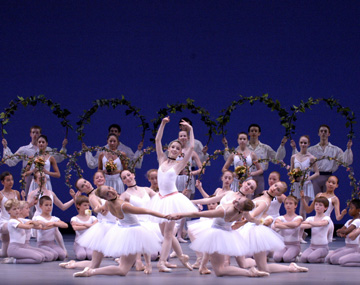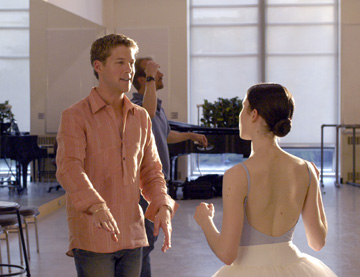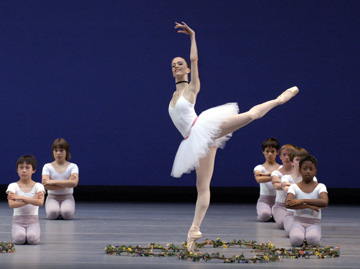Before There Was After
Le
Jardin Animé
Pacific Northwest Ballet School Performance
McCaw Hall
Seattle, Washington
June 19, 2004
By
Sandra Kurtz
Copyright
© 2004 by Sandra Kurtz
published July 1, 2004
 In
any given dance season, someone with a generous travel budget and a good
day planner could see several productions of Swan Lake, all of
them different from one another, and all of them claiming to be "after
Petipa." Chronologically speaking, all productions since 1910 when
he died should be marked "after Petipa"—but that's not
what the preposition means here. "After" isn't about time, it's
about attribution, a much trickier subject.
In
any given dance season, someone with a generous travel budget and a good
day planner could see several productions of Swan Lake, all of
them different from one another, and all of them claiming to be "after
Petipa." Chronologically speaking, all productions since 1910 when
he died should be marked "after Petipa"—but that's not
what the preposition means here. "After" isn't about time, it's
about attribution, a much trickier subject.
In general, choreography has been handed down through generations with less care than old family recipes for apple pie. Just as a cook may have to substitute white sugar for brown at some point, depending on the contents of her larder, a stager may make similar compromises, altering a phrase to suit a particular dancer or cutting a sequence to accommodate the size of the stage or the limitations of the budget. But for the baker, the written recipe holds the truth of the work, a kind of Platonic record of the pie without compromise—for the next stager of a ballet, the altered work they themselves performed is often used as the gold standard for the subsequent production.
Despite the development of several dance notation systems throughout history (and in the interests of full disclosure—I sometimes teach Labanotation), the majority of the dance world is still hesitant to believe that you can get movement from a page of symbols. Even though there are dance scores for some of Petipa's work, recorded in Stepanov notation, it's only been recently that those scripts have been mined for the information they contain. And so, looking at a reconstruction of the "Jardin Animé" section of Petipa's Le Corsaire is a bit like opening a burial chamber in an Egyptian pyramid—not only can we see how the ballet has changed, but in this staging by Doug Fullington and Manard Stewart for the Pacific Northwest Ballet School, we can see more generally what time has done to our expectations of classical dancing.
 The
broad outlines of the reconstructed version are already familiar to people
who know the handed-down production. As a diversion inside a program-length
ballet, "Jardin" is relatively free of any narrative—it
doesn't tell part of the story or establish any characters. With two solo
women and an ensemble of 66, including a handful of children, this is
Petipa in his traffic officer mode, moving groups of dancers around the
stage in an orderly fashion. It is the kind of work that reads as well
from the balcony as the orchestra.
The
broad outlines of the reconstructed version are already familiar to people
who know the handed-down production. As a diversion inside a program-length
ballet, "Jardin" is relatively free of any narrative—it
doesn't tell part of the story or establish any characters. With two solo
women and an ensemble of 66, including a handful of children, this is
Petipa in his traffic officer mode, moving groups of dancers around the
stage in an orderly fashion. It is the kind of work that reads as well
from the balcony as the orchestra.
Although the general picture is similar to contemporary productions, when you look more closely there are significant differences in this "new" old version. As well as some deliberate choices by Fullington and Stewart (replacing the Cesare Pugni interpolations with the original score by Leo Delibes, and restoring the original order), their decision to stage exactly what they read in the score points up some fascinating distinctions.
In its original version, Jardin is a much more subtle work. At first, it seems that this comes from a kind of simplified technique, but that turns out to be a false assumption. Instead of the body reaching out through every limb in the neo-classical style we're accustomed to, with elbows fully extended and hips swiveled open, the outline of the dancer is more curved. The arm is slightly foreshortened by softening the elbow and relaxing the hand, and the focus seems to shift to middle-distance rather than far, bringing our attention back to the person and away from the horizons they usually reach for. The dancers often step directly onto a flat foot, rather than rolling down from pointe, so that the length of their stride is shorter as well. Compared to the style these students are trained in today, in this ballet they inhabit a more intimate world.
 If
they are not eating up the space, they are using that energy on some devilishly
tricky dancing. In this case, virtuosity is more a matter of detail than
of amplitude. Although there is no actual mime, the changes in facing
and focus, along with the port de bras, gives it that same kind of gestural
clarity. Frequently, in sequences where the musical phrase is repeated,
the choreography will embroider on the original steps rather than just
recycle the same material. Although we do see this today in soloist and
principal roles, this is salted throughout the corps work here, and makes
for a denser picture when everyone is on stage. As in Petipa's Sleeping
Beauty, the corps manipulates garlands of flowers in several ensemble
sections, creating tunnels and hedges that reinforce the architecture
of the group shapes. Laid on the floor, these garlands become little circles
of flowers, which the soloists dance in and around, like a refined version
of hopscotch. In the most radical difference from the written score, Fullington
and Stewart chose not to use the traditional "garden bed" set
pieces, as their budget couldn't stretch that far. Instead, they substituted
the smallest boys in the school for the garden, kneeling on the floor
and marking the periphery of the "beds." At several points the
soloists leap over these beds, but instead of a grand jete that clears
the obstacle with room to spare, the jump is lower, placed carefully between
two boys—again, the emphasis is on precision rather than size. This
is not an Olympian example of virtuosity (higher, faster, farther) but
instead, a celebration of details.
If
they are not eating up the space, they are using that energy on some devilishly
tricky dancing. In this case, virtuosity is more a matter of detail than
of amplitude. Although there is no actual mime, the changes in facing
and focus, along with the port de bras, gives it that same kind of gestural
clarity. Frequently, in sequences where the musical phrase is repeated,
the choreography will embroider on the original steps rather than just
recycle the same material. Although we do see this today in soloist and
principal roles, this is salted throughout the corps work here, and makes
for a denser picture when everyone is on stage. As in Petipa's Sleeping
Beauty, the corps manipulates garlands of flowers in several ensemble
sections, creating tunnels and hedges that reinforce the architecture
of the group shapes. Laid on the floor, these garlands become little circles
of flowers, which the soloists dance in and around, like a refined version
of hopscotch. In the most radical difference from the written score, Fullington
and Stewart chose not to use the traditional "garden bed" set
pieces, as their budget couldn't stretch that far. Instead, they substituted
the smallest boys in the school for the garden, kneeling on the floor
and marking the periphery of the "beds." At several points the
soloists leap over these beds, but instead of a grand jete that clears
the obstacle with room to spare, the jump is lower, placed carefully between
two boys—again, the emphasis is on precision rather than size. This
is not an Olympian example of virtuosity (higher, faster, farther) but
instead, a celebration of details.
While staging the work, Manard Stewart felt it had an affinity for baroque dance, which he has also practiced, but PNBS faculty member Flemming Halby saw an even stronger relationship to another part of ballet history. Halby, who was trained at the Royal Danish Ballet and performed with that company before he came to the US in the 1960's, commented that it looked just like Bournonville to him. The rounded port de bras, articulation of the foot on the floor, and general deportment reminded him of his early training. This isn't actually a far-fetched relationship—both Bournonville and Petipa came from the French school, each studying with a Vestris there, and one of Bournonville's most devoted pupils, Christian Johansson, was a principal teacher at the Maryinsky School during Petipa's tenure. Fullington and Stewart's staging, with the dancers in plain white tutus and ribbons at their necks, refers to Edgar Degas' paintings of ballet dancers, but the connection does seem to reach further than this pretty allusion.
 Coming
at the end of a lengthy school show, this production of Jardin seemed
to epitomize the idea of "schooling"—young dancers working
carefully and intelligently to master a difficult body of knowledge. Jacquelyn
Arcati, Erin Lewis, and Jeanette Sheard, alternating in the two soloists
roles, are almost at the end of their student days (Lewis will be joining
PNB next season) and rose easily to the multiple challenges of the ballet.
They were able to make hard things seem both easy and important, which
is a very difficult combination, even for seasoned professionals.
Coming
at the end of a lengthy school show, this production of Jardin seemed
to epitomize the idea of "schooling"—young dancers working
carefully and intelligently to master a difficult body of knowledge. Jacquelyn
Arcati, Erin Lewis, and Jeanette Sheard, alternating in the two soloists
roles, are almost at the end of their student days (Lewis will be joining
PNB next season) and rose easily to the multiple challenges of the ballet.
They were able to make hard things seem both easy and important, which
is a very difficult combination, even for seasoned professionals.
Each succeeding generation "after Petipa" has taken that work and enhanced different elements, depending on the resources and skills of the artists at the time. As those different emphases have become institutionalized, our view of what Petipa really was, and what classicism really is, have shifted as well. With productions like this, reaching back to what might have been Petipa's actual intentions, we can see a bit more clearly how we have shaped ballet over time, and how the times have shaped our view of classical dancing.
Photos, all
by Rex Tranter::
First: PNB School student Jeanette Sheard (in foreground) performs
with other PNB School students in the world premiere reconstruction of
Marius Petipa's "Le Jardin Animé" - the featured work
in the 23rd Annual Pacific Northwest Ballet School Performance at McCaw
Hall, Seattle, WA, June 19, 2004
Second: Doug Fullington and Pacific Northwest Ballet School student
Jeanette Sheard in the PNB rehearsal studio (Manard Stewart in the background)
preparing for the world premiere reconstruction of Marius Petipa's "Le
Jardin Animé"
Third: Sixty-eight PNB School students performed in the world premiere
reconstruction of Marius Petipa's "Le Jardin Animé"
Fourth: PNB School student Erin Lewis with boys from PNB School
perform in the world premiere reconstruction of Marius Petipa's "Le
Jardin Animé"
Originally
published:
www.danceviewtimes.com
Volume 2, Number 24
July 1, 2004
Copyright ©2004 by Sandi Kurtz
|
|